Electric Underfloor Heating – FAQ
Who are Varme and why should I buy from you?
Varme is one of Scandinavia’s top brands of electric underfloor heating cables, which are distributed exclusively in the UK. The Varme brand is renowned for its quality and is offered with a manufacturers lifetime guarantee. Our instructions are simple to follow and we also have a freephone technical support line to answer any questions you may have. Our technical support staff are also qualified and certified electrical installers, so we can offer advice and answer any technical questions you may have, before, during or after installation.
Is electric underfloor heating expensive to run?
This is the most common question we get and the simple answer is, that the running costs are determined by many different factors so it is difficult to generalise. When the systems are used in a well-insulated building (in line with current building regulations) the running costs are usually very low, the thermostatic control in each room/zone means that you only use just enough energy to maintain your desired room temperature. Based on the default thermostat settings, a 1kw system will cost approximately £0.40 a day, based on an average house with an average level of insulation.
How simple are your systems to install?
See our installation pages under each system type – our systems are designed to be laid by anyone with basic DIY skills, but all electrical connections must be carried out by a suitably qualified electrician and in accordance with current regulations.
How warm will the floor get?
Our systems are designed so that the floor surface will feel comfortably warm , but will never get too hot to walk on! The thermostat regulates the floor temperature by turning the system off when the floor gets to the required temperature, then back on as the floor begins to cool – thus keeping a constant temperature. It does this up to 3 times per minute for optimum control and maximum energy efficiency.
Can the underfloor heating be used as a primary heat source?
In the vast majority of cases the answer will be yes, especially in new, well-insulated properties. The exceptions being old properties with little or no insulation, where you have limited floor space available, such as a small galley kitchen, or a small bathroom. In such cases if may be physically impossible to get enough heat output into a small confined space. If you wish to install a primary heating system in an old poorly insulated property, please contact us for advice.
Can the temperature be regulated?
Yes it can – The FH-01 thermostat controller allows the user full control of the heating system, including the ‘occupied’ temperature, the ‘unoccupied’ temperature and the times of operation using a 7-day/24 hr clock control.
What is the typical warm up time?
How long it takes to heat the floor will vary, depending on your sub-floor and its insulation. Generally the better the insulation the quicker it will heat up, 30 minutes to an hour on a wooden floor, but it will take longer on an un-insulated concrete floor. However, on concrete floors it will also retain the heat in the concrete and therefore take longer to cool down. The carbon film system is supplied with a thin insulation layer so warm up times will be no more than an hour on any sub-floor. However with tiles, if you lay the cables/cable mats onto un-insulated concrete, it can take several hours to heat up. We therefore recommend that you try to use Varme insulated tile-backer boards wherever possible when installing on an un-insulated concrete floor.
Is there a guarantee?
Yes all cables are backed by a manufacturers lifetime guarantee! The thermostat is guaranteed for five years from date of purchase.
What is the thickness of the under-tile cable/cable mats?
The cables are just 3mm thick and include a built in return so they only need to be connected from one end.
What is the thickness of the carbon system?
The carbon film itself is less than half a millimetre thick and when combined with our 6mm ‘Depron’ insulating underlay below a wood floor, the total combined thickness of the complete system will raise your floor level by just 6.5mm.(Note in a conservatory or on an un-insulated floor, we recommend a double layer of Depron making the increase in floor height 12.5mm)
Can the carbon system be used below 'real' wood floors or just laminate/engineered wood?
The answer to the question is yes it can and the carbon foil has been fitted below thousands of sqm of real wood floors during the last few years and we have had no reported problems of cracking, warping or damage to the floor. However two things you need to consider if using a real wood floor: The installation method, ‘floating’ is best (where the boards are glued/fixed together using the tongue and groove). It is also possible to install the film onto battens at 400 mm centres – please see our Fitting Instructions for details. The other consideration is the moisture content. Wood is a natural product and as long as you chose timber that is fully dried out and has a low moisture content.
I have a chipboard floor which I wish to tile and also have underfloor heating, do I need to fix a layer of plywood before the underfloor heating and tiles?
(Given directly by a technical advisor from ‘The Tile Association’) There are a lot of chipboard floors around and ideally something else should be done before tiling. Additional plywood is an improvement but current thinking is that 2 layers, with joints lapped, should be used to minimize the possibility of cracking. This would mean putting down say 2 layers of 9 mm each, screw fixed at 300 mm centres. Even use of plywood is not ideal. Another possibility, (better than plywood), would be to put a layer of Varme, Wedi or similar inert tile-backer board down and tile onto that.
Water Underfloor Heating – FAQ
How deep should the insulation be?
A minimum of 100mm is recommended with in-screed systems. 50mm is recommended for joist systems. Overlay systems using Profix or screed board can operate with as little as 10mm of insulation. NEVER lay insulation below EPS overlay boards- these have to be laid onto a solid surface.
How deep should the screed be?
Traditional sand cement screed are laid to a depth between 65-75mm. Liquid screeds usually between 50-60mm.
What is the heat output?
This will vary depending on which type of system has been installed (in-screed, joist or overlay) and what type of flooring has been put down on top of the system. Generally speaking, a screed system with tiles will output 100w/sqm, joist system 65w/sqm and overlay system 120w/sqm.
Can I use block and beam as a sub-floor?
Yes. Block and beam floors allow in-screed systems to be installed on upper floors giving you further choices for the type of underfloor heating system you can install.
Can I install the system myself?
Yes. We provide detailed installation guides with each underfloor heating kit so all the important steps are clearly explained. A good understanding of plumbing and electrics will be required for the boiler connections and thermostats but for the most part installing a system is straightforward for those competent at DIY. Please note though, were recommend hiring a qualified tradesman to do the connections to the boiler and wiring.
How do I pressurize the system?
Close the temperate gauge isolation valves on the manifold. Fully open each isolation valve on the lower manifold and then each flow meter. Connect a hose pipe to the drain/fill point on the right side of the manifold and turn on the water. When the pressure reaches 5 bar close the valve on the fill point. You should notice the gauge in each flow meter move which indicates there is flow through each pipe circuit. DO NOT pressurise the system from the boiler.
When purchasing a kit, will I need anything else?
The screed kits require a layer of foil backed insulation beneath it and a layer of screed over it. Both of these materials need to be purchased separately to complete the installation. The joists kits require 50mm of foil backed insulation lay between the joists. The overlay kits are sold complete and require no additional materials to install.
Do I need to glue EPS overlay boards to the subfloor?
Absolutely! The EPS boards are not designed to be laid as a floating floor and have to be glued down. We recommend Mapei Ultrabond 380 with provides 35sqm coverage per 15kg tub.
Why do I need insulation?
To stop downward heat loss. The heat generated by the system will go in every direction, including down. A thermal barrier directly beneath the underfloor heating system will minimise downward heat loss and force the heat up into the room, maximising the effectiveness of the underfloor heating.
What is screed and why do I need it?
Screed is typically a fibre reinforced sand cement mix that is poured over the pipes to a depth of about 65mm. This acts as a thermal store for the underfloor heating to be effective. The pipes heat the screed and once fully heated, releases it to heat the room. 65mm of screed will hold a LOT of heat once full, which makes screed systems so economical to run, as they only need a constant trickle heat to keep the screed constantly warm.
How much maintenance does underfloor heating require?
Almost none. Underfloor heating systems are generally maintenance free but to ensure the underfloor heating works perfectly for decades we recommend a yearly flush of the system to remove any contaminants they may have built up in the system. You can usually see when this happens as the flow meters become dirty.
I've damaged the pipe during installation! What should I do?
Don’t panic! It’s simple to fix. Simply cut that section of pipe out and replace it with a repair coupler.
How hot does the floor get?
Between 20-30°c, depending on the temperature you have set on the mixing valve and on the thermostat
I'm going to lay a wood based flooring. Do I need to take any precautions?
Regardless if you’re installing an in-screed, joists or overlay system, you will need to install a floor probe to measure the room temperature. This will limit the floor temp to never rise about 27°c.
Can I turn off my underfloor heating completely?
Yes. Simply turn the underfloor heating thermostat off and the system will turn off. For screeded floor allow approximately 45 minutes to completely cool.
Is there a warranty?
Our underfloor heating systems come with a 3 year warranty
Are there any guarantees?
Our underfloor heating pipe has a 50 year guarantee.
What are zones?
A zone is an individual circuit of continuous pipe without joins no more than 100m in length from output to return on the manifold. The heat output in each zone can be controlled individually by its own thermostat or for larger room with several zones, 1 thermostat controls all zones.
Why should a zone not exceed 100m of pipe?
Beyond 100m of pipe length the pumps cannot get the hot water effectively around the system resulting in cold spots and poor heat output. For an effective underfloor heating system we highly recommend you do not use more than 100m of pipe per zone.
Is there an alternative to using aluminium spreader plates over a suspended floor?
Yes. Using a pre-grooved 50mm insulation board covered with a pre-bonded 500 micron aluminium layer. This inserts between the joists onto battens and the pipe inserts into the grooves. Alternatively you lay the pipe onto the insulation between the joist then cover with a 25mm dry screed mix. This method adds approximately 28kg/sqm additional load to the joists and we advise you seek approval from a structural engineer before proceeding if in doubt.
Joule-Therm Ceramic Radiators – FAQ
Is your system suitable to replace old storage heating?
The JouleTherm system has been designed primarily for that purpose but it can also be used for every type of heating.
Are they expensive to run?
We get asked this question a lot and the answer is No. The Joule Therm heating system has been carefully designed to operate with low running costs. The Kaolin / Ceramic heating plates heat up extremely fast and cool down very slow only using about 15 – 25 minutes of electricity per hour.
How can I be sure the Joule Therm heaters do not use a lot of electricity?
The JouleTherm radiators have been tested for temperature control and running costs by the NSAI labourites in Dublin, Ireland. Please read our testimonial.
How long are they covered under Warranty?
The warranty period is for 2 years from date of purchase. A proof of purchase is required to validate all warranty issues.
Do you offer discount?
Yes like every business we offer discounts to our customers but not on single purchases. For multiple orders and installation costs we can offer discounts.
How do I know what type of radiator I need for my home? Do you have a guideline for measuring rooms?
As a general rule we usually tell our customers that they require 100 watts of heat per meter square of space. Click here to read our guidelines on measuring for our JouleTherm radiators.
Can I simply plug the radiator into the wall socket in my home?
Yes the JouleTherm radiators have been designed for that purpose but for multiple radiators we always recommend seeking advise before proceeding.
How many radiators can the JS10/2 touch screed controller control?
The JS10/2 controller can control 5 zones with a total of 8 radiators per zone, so to answer your question it can control up to 40 radiators.
How long does it take to heat up a room?
Depending on the building fabric of your room it would typically take approximately 40 minutes to heat the room from cold and then after that only use between 15 – 25 minutes of electricity per hour.
How long would it take to fit out a 3 bedroom house with your system?
Generally, 1 day would be enough for a qualified electrician to get the whole system up a running.
Do you accept credit and debit cards?
Yes we do. We can accept your payment over the phone through our secure merchant service provider
-
Manuals & Guides
Download our handy installation PDF guides
Download Manuals ››
for help with your underfloor heating installation... -
Confused??
New to underfloor heating? Not sure
Learn more ››
where to begin?
We've got you covered... -
Get a Quote...
Get a full and detailed quotation for your
Get a Quote ››
complete underfloor heating system... -
Need Help?
Just get in touch and one of our friendly members of
Get in touch with us ››
staff will help answer any questions you may have...

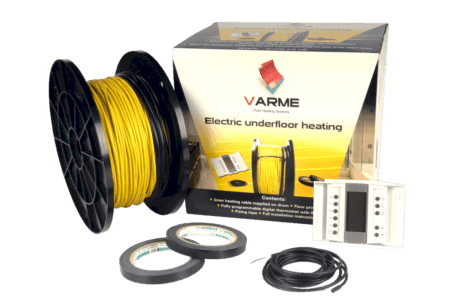
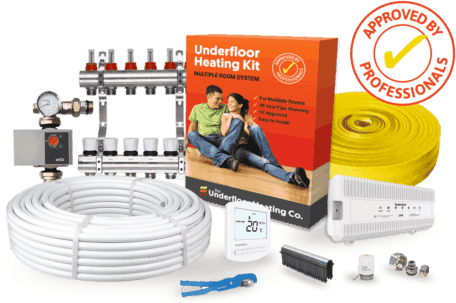
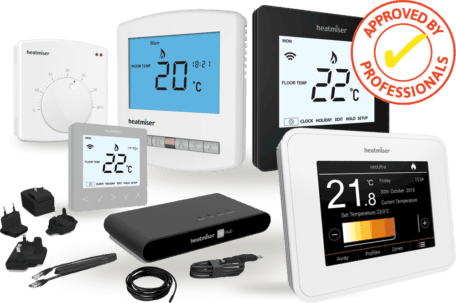
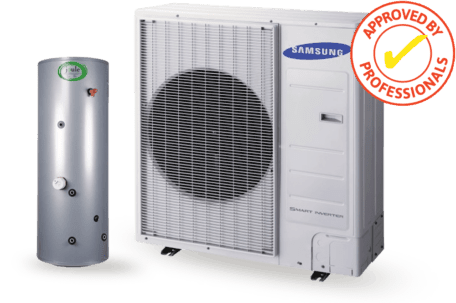
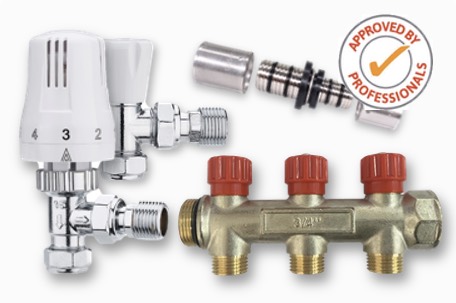
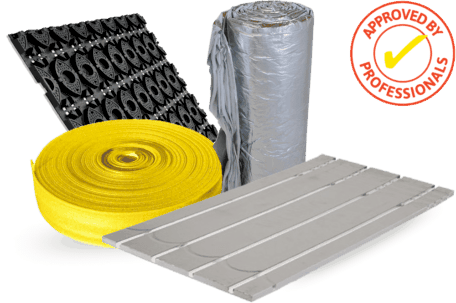
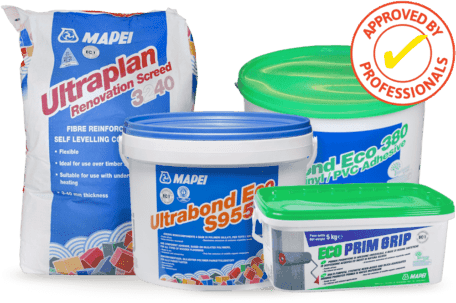







 Trade Prices
Trade Prices  Fast Delivery
Fast Delivery  Rated Excellent
Rated Excellent  30 Day Returns
30 Day Returns  100% Secure Shopping
100% Secure Shopping